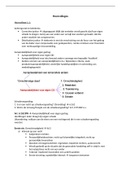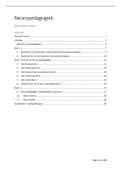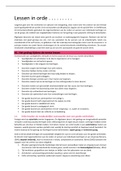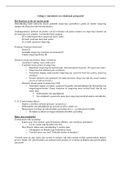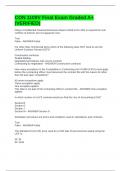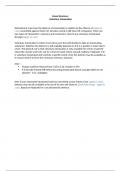UNISA
LEV3701
ASSIGNMENT 1
2024
, MULTI CHOICE QUESTIONS
EVI301-A
2010 Second Semester – Assignment 1
Question 1
(a) If the current South African law does not provide a solution to an evidentiary problem, our courts
will first of all search for the answer in the early Roman-Dutch law.
(b) Evidence obtained in a manner that violates the Constitution will always be inadmissible.
(c) Substantive law indicates which procedure must be followed to prove a case.
(d) The “facts in dispute” in a particular case are heavily influenced by the applicable substantive law.
(1) Only statements (a) and (b) are correct.
(2) Only statements (a), (b) and (d) are correct.
(3) Only statement (c) is correct.
(4) Only statement (d) is correct.
(5) All the statements are correct.
Question 2
(a) In the case of a residuary clause, our courts have to determine what the English law was
immediately before South Africa became a Republic in 1961.
(b) Roman-Dutch law is the common law of South Africa and therefore constitutes the historical source
of our substantive and formal law.
(c) In terms of section 35(1) of the Constitution, every arrested person has the right to adduce and
challenge evidence.
(d) A finding by a court that a particular piece of evidence is inadmissible due to irrelevance is final and
cannot be reconsidered during the course of the same trial.
(1) Only statement (a) is correct.
(2) Only statements (a), (b) and (c) are correct.
(3) Only statements (c) and (d) are correct.
(4) Only statements (a) and (d) are correct.
(5) All the statements are correct.
Question 3
(a) A person is charged with fraud in that he made a false statement to a financial institution. Evidence
that this person has, on previous occasions, made similar false statements to other financial
institutions, is hearsay evidence.
(b) A person is charged with fraud in that he made a false statement to a financial institution. Evidence
that this person has, on previous occasions, made similar false statements to other financial
institutions, is evidence about previous consistent statements.
(c) The accused, in trying to dispute the admissibility of a confession made while he was in detention,
wants to tender evidence that, on other occasions, the police have used improper means to get
statements from him. This evidence is evidence of previous consistent statements.
(d) The accused is charged with dealing in dagga. The fact that the accused has previously been
convicted of dealing in dagga is hearsay evidence.
(1) Only statement (a) is correct.
(2) Only statement (b) is correct.
(3) Only statement (c) is correct.
(4) Only statements (c) and (d) are correct.
(5) None of the statements is correct.
Question 4
(a) A similar fact may be distinguished from a previous consistent statement in that a similar fact will
seldom, if ever, take the form of a statement.
,EVI301-A Page 2 of 27
(b) Similar fact evidence can only be used by the state, since the law prohibits the accused from using
similar fact evidence to his advantage.
(c) Section 197 of the Criminal Procedure Act 51 of 1977 protects an accused against answering
certain questions during cross-examination, but this protection falls away where the accused gives
evidence against any other person charged with the same offence or an offence in respect of the
same facts.
(d) When evidence about someone’s character is important for purposes of the law of evidence, the
common law states that only evidence of the general reputation of such a person may be
presented.
(1) Only statements (a) and (b) are correct.
(2) Only statement (c) is correct.
(3) Only statements (a), (c) and (d) are correct.
(4) Only statement (d) is correct.
(5) All the statements are correct.
Question 5
Section 35(5) of the Constitution reads as follows:
(a) “Evidence obtained in a manner that violates any right in the Bill of Rights can be excluded if the
admission of that evidence would render the trial unfair or otherwise be detrimental to the
administration of justice.”
(b) “Evidence obtained in a manner that violates any right in the Bill of Rights should be excluded if the
admission of that evidence would be detrimental to the administration of justice or otherwise render
the trial unfair.”
(c) “Evidence obtained in a manner that violates any right in the Bill of Rights must be excluded if the
admission of that evidence would render the trial unfair or otherwise be detrimental to the
administration of justice.”
(d) “Evidence obtained in a manner that violates any right in the Bill of Rights must be excluded if the
admission of that evidence would render the trial unfair and also be detrimental to the
administration of justice.”
(1) Only statement (a) is correct.
(2) Only statement (b) is correct.
(3) Only statement (c) is correct.
(4) Only statement (d) is correct.
Question 6
(a) In the case of an alleged offence of a sexual nature, evidence of a previous consistent statement
will inter alia be admissible if the complaint was made at the first reasonable opportunity, but not
later than 48 hours after the offence was committed.
(b) A number of principles have over time developed to ensure the fairness of an identification parade.
One principle is that it is important that the people in the line-up do not wear similar clothes.
(c) There is question of a previous consistent statement when, during testimony in court, a witness
repeats a statement consistent with one made on a previous occasion, in order to corroborate his
evidence.
(d) There is question of a previous consistent statement when a witness repeats a consistent
statement made by another witness on a previous occasion, which serves as self-corroboration for
the other witness.
(1) Only statements (a) and (c) are correct.
(2) Only statements (b), (c) and (d) are correct.
(3) Only statement (c) is correct.
(4) Only statements (c) and (d) are correct.
(5) Only statement (d) is correct.
Question 7
In the course of a civil matter the plaintiff wants to present the record of a witness’ testimony in a criminal
trial based on the same facts, as evidence against the defendant. Consider the following statements:
(a) The evidence will be hearsay evidence.
Compiled by Pikkie
, EVI301-A Page 3 of 27
(b) The evidence will be opinion evidence.
Later in the same civil matter the plaintiff wants to furnish the record of the court’s finding in the previous
criminal matter as evidence in the civil matter.
(c) The evidence is admissible hearsay evidence.
(d) The evidence is admissible opinion evidence.
(1) Only statement (a) is correct.
(2) Only statements (b) and (d) are correct.
(3) Only statements (a) and (c) are correct.
(4) Only statement (d) is correct.
(5) Only statements (b) and (c) are correct.
Question 8
(a) If a witness in a criminal case tells the court that something was admitted or confessed by a non-
testifying accused, such evidence strictly speaking amounts to hearsay evidence.
(b) Hearsay evidence consists of oral evidence about that which a witness previously heard and wants
to testify about in court. Hearsay can therefore never be in a written form.
(c) The court's approach in McDonald’s Corp v Joburgers Drive-Inn Restaurant 1997 (1) SA 1 (A)
provides a good example of how the common law hearsay-exceptions should today be handled.
(d) Although a court has a discretion to allow hearsay evidence, this discretion will more readily be
exercised in criminal than in civil matters.
(1) Only statement (a) is correct.
(2) Only statements (a), (b) and (d) are correct.
(3) Only statements (a) and (c) are correct.
(4) Only statement (b) is correct.
(5) Only statements (b) and (d) are correct.
Question 9
(a) A statement that contains a defence can never be a confession.
(b) A confession can only be used as evidence in court if it was also reduced to writing at the time it
was made.
(c) If an accused gives evidence about a statement which is to his advantage and which forms part of
an inadmissible confession, the otherwise inadmissible confession might become admissible.
(d) If you make a confession to a friend (who is not also a peace officer), evidence about that
confession will be inadmissible, unless your friend is also a justice of the peace.
(1) Only statements (a) and (c) are correct.
(2) Only statements (a) and (d) are correct.
(3) Only statement (d) is correct.
(4) Only statements (b) and (c) are correct.
(5) All the statements are correct.
Question 10
The investigating officer takes A, the accused in a murder case, to a place in the bush where A points out
a pistol. “This is the pistol”, he declares. Ballistic tests confirm that the pistol was used to kill the
deceased. A’s behaviour (not his statement) is:
(a) a formal admission.
(b) an informal admission.
(c) an informal admission by conduct.
(d) a confession by conduct.
(1) Only statement (a) is correct.
(2) Only statement (b) is correct.
(3) Only statement (c) is correct.
(4) Only statement (d) is correct.
(5) None of the statements is correct.
Compiled by Pikkie
LEV3701
ASSIGNMENT 1
2024
, MULTI CHOICE QUESTIONS
EVI301-A
2010 Second Semester – Assignment 1
Question 1
(a) If the current South African law does not provide a solution to an evidentiary problem, our courts
will first of all search for the answer in the early Roman-Dutch law.
(b) Evidence obtained in a manner that violates the Constitution will always be inadmissible.
(c) Substantive law indicates which procedure must be followed to prove a case.
(d) The “facts in dispute” in a particular case are heavily influenced by the applicable substantive law.
(1) Only statements (a) and (b) are correct.
(2) Only statements (a), (b) and (d) are correct.
(3) Only statement (c) is correct.
(4) Only statement (d) is correct.
(5) All the statements are correct.
Question 2
(a) In the case of a residuary clause, our courts have to determine what the English law was
immediately before South Africa became a Republic in 1961.
(b) Roman-Dutch law is the common law of South Africa and therefore constitutes the historical source
of our substantive and formal law.
(c) In terms of section 35(1) of the Constitution, every arrested person has the right to adduce and
challenge evidence.
(d) A finding by a court that a particular piece of evidence is inadmissible due to irrelevance is final and
cannot be reconsidered during the course of the same trial.
(1) Only statement (a) is correct.
(2) Only statements (a), (b) and (c) are correct.
(3) Only statements (c) and (d) are correct.
(4) Only statements (a) and (d) are correct.
(5) All the statements are correct.
Question 3
(a) A person is charged with fraud in that he made a false statement to a financial institution. Evidence
that this person has, on previous occasions, made similar false statements to other financial
institutions, is hearsay evidence.
(b) A person is charged with fraud in that he made a false statement to a financial institution. Evidence
that this person has, on previous occasions, made similar false statements to other financial
institutions, is evidence about previous consistent statements.
(c) The accused, in trying to dispute the admissibility of a confession made while he was in detention,
wants to tender evidence that, on other occasions, the police have used improper means to get
statements from him. This evidence is evidence of previous consistent statements.
(d) The accused is charged with dealing in dagga. The fact that the accused has previously been
convicted of dealing in dagga is hearsay evidence.
(1) Only statement (a) is correct.
(2) Only statement (b) is correct.
(3) Only statement (c) is correct.
(4) Only statements (c) and (d) are correct.
(5) None of the statements is correct.
Question 4
(a) A similar fact may be distinguished from a previous consistent statement in that a similar fact will
seldom, if ever, take the form of a statement.
,EVI301-A Page 2 of 27
(b) Similar fact evidence can only be used by the state, since the law prohibits the accused from using
similar fact evidence to his advantage.
(c) Section 197 of the Criminal Procedure Act 51 of 1977 protects an accused against answering
certain questions during cross-examination, but this protection falls away where the accused gives
evidence against any other person charged with the same offence or an offence in respect of the
same facts.
(d) When evidence about someone’s character is important for purposes of the law of evidence, the
common law states that only evidence of the general reputation of such a person may be
presented.
(1) Only statements (a) and (b) are correct.
(2) Only statement (c) is correct.
(3) Only statements (a), (c) and (d) are correct.
(4) Only statement (d) is correct.
(5) All the statements are correct.
Question 5
Section 35(5) of the Constitution reads as follows:
(a) “Evidence obtained in a manner that violates any right in the Bill of Rights can be excluded if the
admission of that evidence would render the trial unfair or otherwise be detrimental to the
administration of justice.”
(b) “Evidence obtained in a manner that violates any right in the Bill of Rights should be excluded if the
admission of that evidence would be detrimental to the administration of justice or otherwise render
the trial unfair.”
(c) “Evidence obtained in a manner that violates any right in the Bill of Rights must be excluded if the
admission of that evidence would render the trial unfair or otherwise be detrimental to the
administration of justice.”
(d) “Evidence obtained in a manner that violates any right in the Bill of Rights must be excluded if the
admission of that evidence would render the trial unfair and also be detrimental to the
administration of justice.”
(1) Only statement (a) is correct.
(2) Only statement (b) is correct.
(3) Only statement (c) is correct.
(4) Only statement (d) is correct.
Question 6
(a) In the case of an alleged offence of a sexual nature, evidence of a previous consistent statement
will inter alia be admissible if the complaint was made at the first reasonable opportunity, but not
later than 48 hours after the offence was committed.
(b) A number of principles have over time developed to ensure the fairness of an identification parade.
One principle is that it is important that the people in the line-up do not wear similar clothes.
(c) There is question of a previous consistent statement when, during testimony in court, a witness
repeats a statement consistent with one made on a previous occasion, in order to corroborate his
evidence.
(d) There is question of a previous consistent statement when a witness repeats a consistent
statement made by another witness on a previous occasion, which serves as self-corroboration for
the other witness.
(1) Only statements (a) and (c) are correct.
(2) Only statements (b), (c) and (d) are correct.
(3) Only statement (c) is correct.
(4) Only statements (c) and (d) are correct.
(5) Only statement (d) is correct.
Question 7
In the course of a civil matter the plaintiff wants to present the record of a witness’ testimony in a criminal
trial based on the same facts, as evidence against the defendant. Consider the following statements:
(a) The evidence will be hearsay evidence.
Compiled by Pikkie
, EVI301-A Page 3 of 27
(b) The evidence will be opinion evidence.
Later in the same civil matter the plaintiff wants to furnish the record of the court’s finding in the previous
criminal matter as evidence in the civil matter.
(c) The evidence is admissible hearsay evidence.
(d) The evidence is admissible opinion evidence.
(1) Only statement (a) is correct.
(2) Only statements (b) and (d) are correct.
(3) Only statements (a) and (c) are correct.
(4) Only statement (d) is correct.
(5) Only statements (b) and (c) are correct.
Question 8
(a) If a witness in a criminal case tells the court that something was admitted or confessed by a non-
testifying accused, such evidence strictly speaking amounts to hearsay evidence.
(b) Hearsay evidence consists of oral evidence about that which a witness previously heard and wants
to testify about in court. Hearsay can therefore never be in a written form.
(c) The court's approach in McDonald’s Corp v Joburgers Drive-Inn Restaurant 1997 (1) SA 1 (A)
provides a good example of how the common law hearsay-exceptions should today be handled.
(d) Although a court has a discretion to allow hearsay evidence, this discretion will more readily be
exercised in criminal than in civil matters.
(1) Only statement (a) is correct.
(2) Only statements (a), (b) and (d) are correct.
(3) Only statements (a) and (c) are correct.
(4) Only statement (b) is correct.
(5) Only statements (b) and (d) are correct.
Question 9
(a) A statement that contains a defence can never be a confession.
(b) A confession can only be used as evidence in court if it was also reduced to writing at the time it
was made.
(c) If an accused gives evidence about a statement which is to his advantage and which forms part of
an inadmissible confession, the otherwise inadmissible confession might become admissible.
(d) If you make a confession to a friend (who is not also a peace officer), evidence about that
confession will be inadmissible, unless your friend is also a justice of the peace.
(1) Only statements (a) and (c) are correct.
(2) Only statements (a) and (d) are correct.
(3) Only statement (d) is correct.
(4) Only statements (b) and (c) are correct.
(5) All the statements are correct.
Question 10
The investigating officer takes A, the accused in a murder case, to a place in the bush where A points out
a pistol. “This is the pistol”, he declares. Ballistic tests confirm that the pistol was used to kill the
deceased. A’s behaviour (not his statement) is:
(a) a formal admission.
(b) an informal admission.
(c) an informal admission by conduct.
(d) a confession by conduct.
(1) Only statement (a) is correct.
(2) Only statement (b) is correct.
(3) Only statement (c) is correct.
(4) Only statement (d) is correct.
(5) None of the statements is correct.
Compiled by Pikkie

